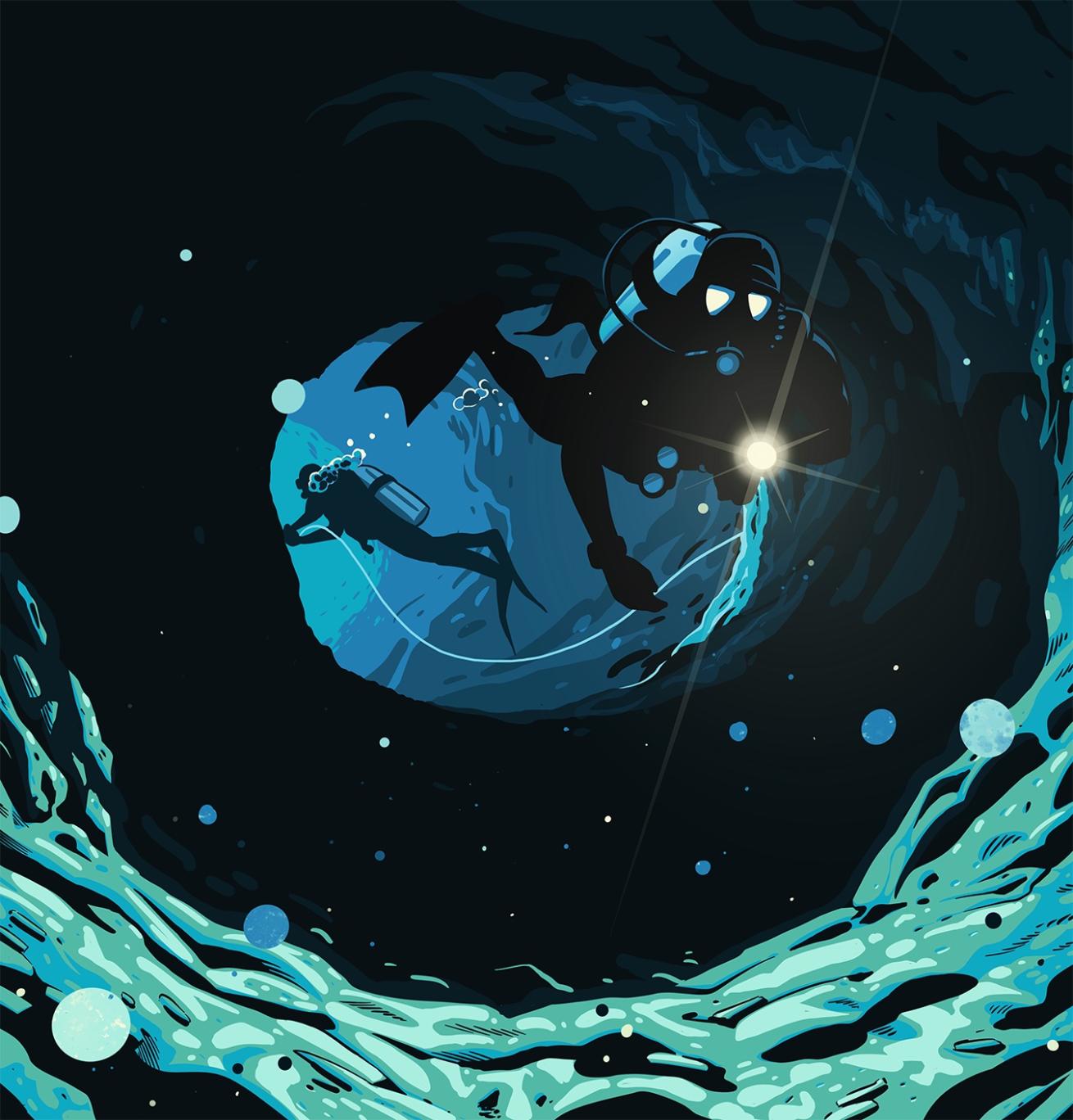Missing Thread | Lessons for Life

Illustration: Steven P. HughesBuddy separation during a cave dive ends in tragedy.
Mitch and Craig were exploring part of a cave system that was new to them. It was always exciting to visit submerged caves that only a handful of people had ever seen; it made them both feel like astronauts landing on the moon. The dive was going well until Mitch left the cave line that Craig had laid to quickly investigate an opening to a new passage. When Mitch returned to the line, Craig was gone. He waited for a few minutes, but when Craig failed to reappear, Mitch got worried.
The Diver
Mitch was a 58-year-old certified cave diver with no relevant medical conditions.
The Dive
Mitch and Craig entered a cave system they had dived together many times before, planning to explore a branching cave for the first time. Craig took the lead, laying the line that would lead them back out of the cave. He tied it off outside the cave entrance and began unspooling the reel he carried. Conditions inside the cave system were good. There was little particulate matter in the water and only a mild current in the main channel of the cave, and no current in the unexplored channel.
The Accident
Craig realized Mitch wasn’t behind him, and after waiting a few minutes he began searching for his buddy. He followed his own cave line back, and eventually found the entrance. He left the line and the reel on the cave floor in case Mitch found it on his own. Craig waited at the cave entrance as long as he could, but eventually had to surface. He immediately alerted the authorities that Mitch was missing. A team of rescue divers found Mitch’s body about three hours later in a cave that branched off of the one he and Craig had been exploring.
Analysis
Investigators found a guide line inside the cave left behind by another dive team. They concluded that Mitch had separated from Craig and began following the wrong line into a different part of the cave system. During Craig’s inconclusive search, Mitch had already moved away into the offshoot cave and out of Craig’s trajectory. He became disoriented and unable to find his way back to the surface and ultimately drowned. He had likely been conscious to watch his air supply drop to zero.
Even experienced cave divers can make deadly mistakes. Cave diving is inherently riskier than diving in open water, and it requires additional training, equipment and practice. You should never enter an overhead environment without the proper preparation. An overhead environment is any situation where you cannot make a direct ascent to the surface. This includes entering a shipwreck, ice diving or diving inside a cave system. It also includes a situation where you have obligated decompression time on a dive because you cannot make a direct ascent to the surface.
Unfortunately, many of the overhead-environment safety rules and procedures were developed after someone died making a mistake. Sheck Exley was one of the first cave divers to examine cave diving accidents and to codify a set of rules for survival. He published his rules in the book Basic Cave Diving: A Blueprint for Survival.
The Rules of Cave Diving
- Be trained for cave diving, and remain within the limits of your training.
- Maintain a continuous guide line to the cave exit.
- Keep two-thirds of your starting gas volume in reserve to exit the cave.
- Remain within the safest possible operating limits for your breathing media.
- Use three sources of light.
In this case, Mitch likely left the safety line to check on something that looked interesting, violating the second rule. Mitch should have alerted his buddy that he wanted to look at something so that Craig could wait for him. Then he should have tied a line from his own cave reel to their main line while he took the side trip. That way he could have found his way back without incident.
In a cave, it is easy to get confused. Everything can look the same. Cave formations can block your line of sight, limiting it to a few feet in some situations. Another important consideration is buddy awareness. Small problems can quickly turn into larger ones. A diver can get into trouble on a shallow dive just as easily as on a deep dive. Stay in contact with your buddy to assist each other if a problem arises.
Lastly, both divers should have maintained situational awareness of the cave and each other. Craig should have noticed the absence of Mitch’s light behind him. Had he stopped immediately to figure out what happened, maybe they wouldn’t have gotten so separated. Mitch should have paid close attention to his surroundings so that he could have found his way back out of the cave.
These lessons are just as applicable to open-water divers. You should always know where your buddy is, and the route back to the boat.
Lessons For Life
- Seek training before diving in any sort of overhead environment. This includes diving under ice, inside a shipwreck, or into a cave system.
- Stay with your buddy. Diving is a team activity, and incident data statistics show that being with a buddy increases the likelihood of a good outcome if something goes awry.
- Don’t get complacent. Don’t let comfort in an environment make you complacent. Just because you’ve done something dozens, or even hundreds, of times, you still need to follow the rules, like keeping a continuous guide line.










